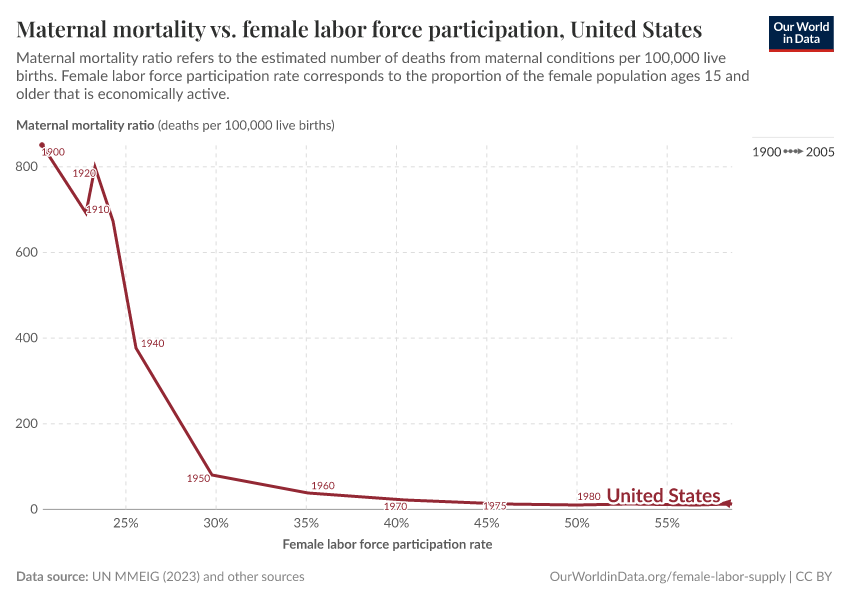Maternal mortality ratio

What you should know about this indicator
Maternal deaths are defined as a death of a woman while pregnant or within 42 days of termination of pregnancy, irrespective of the duration and site of pregnancy, from any cause related or aggravated by the pregnancy or its management, but not from accidental or incidental causes.
Related research and writing
Sources and processing
This data is based on the following sources
How we process data at Our World in Data
All data and visualizations on Our World in Data rely on data sourced from one or several original data providers. Preparing this original data involves several processing steps. Depending on the data, this can include standardizing country names and world region definitions, converting units, calculating derived indicators such as per capita measures, as well as adding or adapting metadata such as the name or the description given to an indicator.
At the link below you can find a detailed description of the structure of our data pipeline, including links to all the code used to prepare data across Our World in Data.
Notes on our processing step for this indicator
- The dataset combines three sources: WHO Mortality Database (before 1985), Gapminder (before 1985, if WHO Mortality Database data are unavailable), UN MMEIG (1985 onwards). The WHO Mortality Database and Gapminder contain reported figures from countries, and are likely to underestimate the true maternal mortality figures. The UN MMEIG aims to estimates the true rate, by adjusting for underreporting and misclassification. Sudden jumps in mortality rate in 1985 are a consequence of switching data sources (from reported to estimated figures).
- For the years between 1950 - 1985 we calculated the maternal mortality ratio and maternal mortality rate based on the number of maternal deaths from the WHO mortality database and live births and female population of reproductive age from the UN WPP.
- Where the reported maternal deaths in the WHO Mortality Database differed significantly from the estimated figures in the UN MMEIG data, we opted not to include them.
- Where a data point is attached to a range of years in the Gapminder data set, we used the midpoint of the range.
- The UN MMEIG data shown (post 1985) is the point estimate - this means there is a 50% chance that the true measure lies above this point, and a 50% chance that the true value lies below this point.
- We calculated regional aggregates by summing the maternal deaths and live births of all countries in the region and then calculating the MMR based on these figures.
Reuse this work
- All data produced by third-party providers and made available by Our World in Data are subject to the license terms from the original providers. Our work would not be possible without the data providers we rely on, so we ask you to always cite them appropriately (see below). This is crucial to allow data providers to continue doing their work, enhancing, maintaining and updating valuable data.
- All data, visualizations, and code produced by Our World in Data are completely open access under the Creative Commons BY license. You have the permission to use, distribute, and reproduce these in any medium, provided the source and authors are credited.
Citations
How to cite this page
To cite this page overall, including any descriptions, FAQs or explanations of the data authored by Our World in Data, please use the following citation:
“Data Page: Maternal mortality ratio”, part of the following publication: Max Roser and Hannah Ritchie (2013) - “Maternal Mortality”. Data adapted from UN MMEIG (WHO, UNICEF, UNFPA, World Bank Group and UNDESA/ Population Division), WHO Mortality Database, United Nations, Gapminder. Retrieved from https://ourworldindata.org/grapher/maternal-mortality [online resource]How to cite this data
In-line citationIf you have limited space (e.g. in data visualizations), you can use this abbreviated in-line citation:
UN MMEIG (2023) and other sources – with major processing by Our World in DataFull citation
UN MMEIG (2023); WHO Mortality Database (2024); UN, World Population Prospects (2024); Gapminder (2010) – with major processing by Our World in Data. “Maternal mortality ratio” [dataset]. UN MMEIG (WHO, UNICEF, UNFPA, World Bank Group and UNDESA/ Population Division), “Trends in maternal mortality 2020”; WHO Mortality Database, “WHO Mortality Database”; United Nations, “World Population Prospects”; Gapminder, “Maternal mortality ratio V1” [original data]. Retrieved March 13, 2025 from https://ourworldindata.org/grapher/maternal-mortality